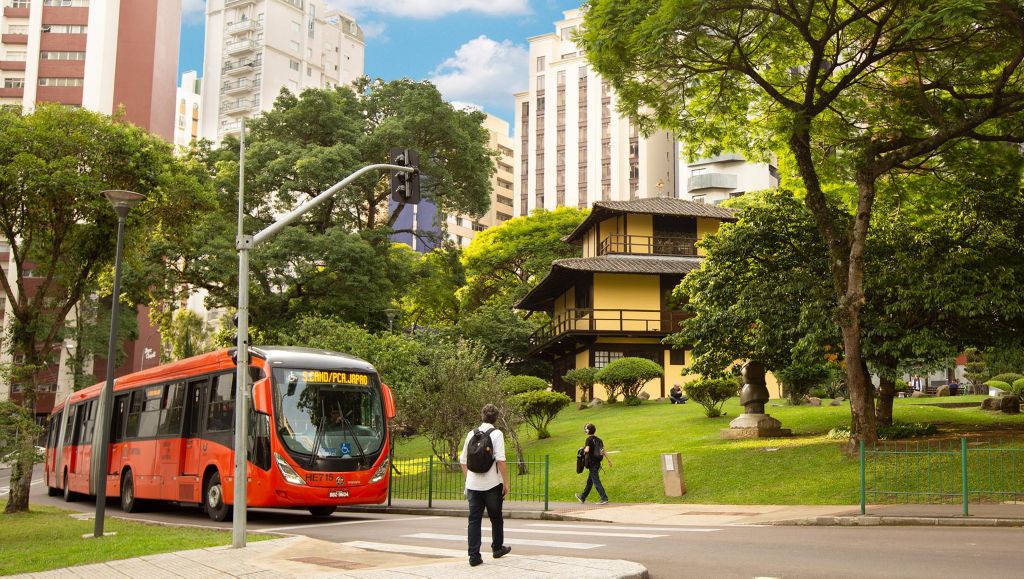Brazil: Connected safety technology cuts accident rates by 50%


It’s 5 pm and rush hour in Curitiba. The Volvo bus travelling south on Bus Rapid Transit (BRT) North Corridor is full of people on their way home from work and schools.
As the bus approaches the entrance to Praça do Japão, the driver prepares to reduce its speed to 30 km/h. This idyllic public space is in one of the city’s safety zones and even if the driver forgets to reduce the speed, the bus will slow down automatically.
The bus is one of 80 new buses in the city that is using Safety Zones, a system that uses remote monitoring and GPS technology to control the vehicle in specific areas.
The system is one of many innovations that the city has adopted to develop its public transport system. Curitiba was the first city in the world to adopt special express bus lanes, known as BRT. Today the network includes six express corridors.
In the BRT North Corridor alone, Urbanization of Curitiba (URBS) a local government-owned company that manages public transport in the city, has mapped out eight safety zones, where the maximum speeds range from between 20 km/h and 60 km/h, depending on the risk of accidents.
Safety Zones has become a key safety feature. It reduces the risk of accidents in places where the traffic dynamic requires extra attention.
Auto Viação Redentor is one of ten companies that operate public transport service in Curitiba. Redentor mainly serves the southern region of the city, which is connected to the North by the BRT lanes. The company has 300 buses, 108 of which are Volvo articulated and bi-articulated. A total of 30 buses are equipped with Safety Zones.
“Even before implementing the new technology, we had mapped out the most high-risk areas and informed our drivers, but we had no way to interact with the vehicles. Volvo’s technology allows us to do that,” says Angelo Gulin Neto, Director at Auto Viação Redentor. “The risk of accidents has been reduced, it's preventive work.”
With a bus network that carries 15 million passengers per month, there are many and varied challenges to maintaining road safety in Curitiba. These risks include inattentive pedestrians with their eyes glued to their cell phones and cyclists crossing BRT´s bus lanes. Even authorised vehicles, such as ambulances and police cars, demand extra caution. In recent years, new intersections for cars have been added to BRT bus lanes. Traffic in Brazilian cities can be somewhat chaotic, for example many drivers don’t use headlights.
Driving on the BRT expressways requires constant attention. Having an automatic speed control system really helps a lot.
When Transporte Coletivo Glória first implemented Safety Zones, the main challenge was to define the size of the safety zone and find a good balance between speed and travel time. “We tested and adapted where and for how long the bus would slow down. In some places, we started with speed reduction zones of 350 meters. Today, that same zone may have been shortened to 200 meters. But preventing accidents is our always our main priority,” he says.
According to Ogeny Pedro Maia Neto, the implementation of Safety Zones on buses in Curitiba has not only reduced the number of accidents, it has also led to other management improvements for URBS. “For example, there is no longer a need to monitor the high-risk areas with radar to prevent speeding. This frees up our workforce to focus on other activities such as managing new passenger facilities. The new technology helps us reach our goal – efficient and accident-free public transport,” he says.
SAFETY ZONES IN SHORT
Through remote monitoring and geolocation, the buses are programmed to keep within the set speed limits in special high-risk areas.
Every time a bus enters one of the safety zones, the connectivity system automatically detects its exact location and adjusts the vehicle’s speed. The driver also receives a warning on the dashboard.
In Brazil, the technology was first introduced in March 2018, when Curitiba began a process of renewing its bus fleet.
Currently 80 Volvo buses (51 bi-articulated and 29 articulated) with Safety Zones are operating in Curitiba.
The technology is implemented on Volvo buses in approximately 20 other countries all over the world.
In some markets the solution is called Volvo Automatic Speed Control.
CURITIBA IS SYNONYMOUS OF BRT
Curitiba's bus system is a global benchmark. Internationally named BRT – Bus Rapid Transit – the model has inspired many cities as an alternative to urban mobility.
Buses run on exclusive bus lanes and passengers board at stations, paying the same standard fare.
Curitiba has six express bus corridors that connect the city. The busiest is the 35-kilometre long North Corridor which transports 350,000 passengers per day.